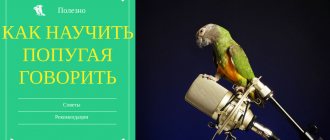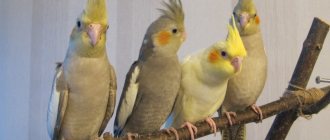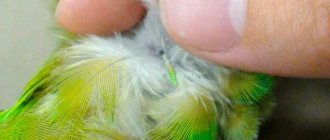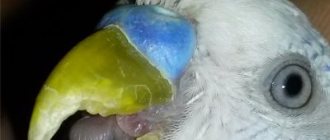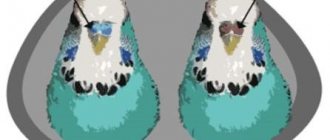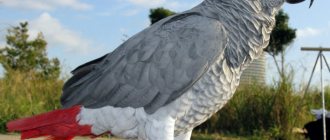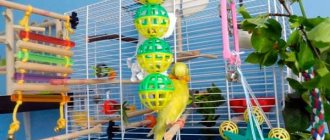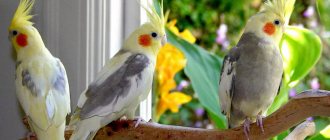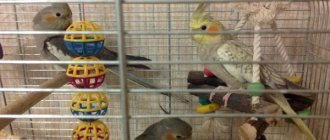Conversation training
Usually, owners are interested not only in how to tame a cockatiel, but also in how to teach it to talk. Indeed, this species of parrot is capable of imitating human speech.
You can start training from the first days the bird appears in the house, calling it by name and repeating the same phrases in conversation. However, the bird will begin to speak only when it becomes interested in a person and wants to communicate with him, that is, after taming.
Practice daily, repeating 1-2 phrases that you want to teach your pet. You can record them on a voice recorder and play them back when the owners are not at home. The bird's speech will be clearer if it is trained by one person and his voice is recorded.
Now you know not only how to tame a cockatiel, but also how to establish a trusting, friendly relationship with your pet and teach it to speak. Be patient, follow the recommendations and you will definitely win the love of this wonderful parrot.
Is it possible to quickly train a parrot to talk?
It is a well-known fact that parrots are capable of reproducing human speech. However, birds do not “talk” on their own. In order for your pet to say at least one word, training is necessary. This process is lengthy; it is not easy to teach a bird to pronounce words. Depending on the bird’s abilities and its species, training can take from 3 months to a year, subject to daily regular training. Note that there are birds that are not capable of reproducing words. Let's look at the most popular types of parrots for their learning ability:
- Wavy. Is it possible to teach a budgie to talk? This species is considered one of the most chatty. They begin to “speak” earlier than others, but it is still not possible to quickly teach them human words. The vocabulary of these birds can reach several hundred words, and their pronunciation can be called perfect. There are cases where budgies reproduced poetry. A trusting relationship with your pet will help speed up the learning process. However, for the bird to “speak” it will take not a single day or even a month.
- Corella. This type of parrot does not have special learning abilities. It is quite possible to teach a cockatiel to talk, but the process is more difficult and lengthy than in the case of budgies. In addition, the vocabulary of these birds is less rich and the pronunciation of words is not as clear. A cockatiel can learn no more than 10 words. Only young individuals can be trained. Adult birds are not capable of reproducing words.
If the pet is young, then training should begin with hand training. After the bird ceases to be afraid of people, they begin directly to speech exercises and activities. Corella is a smart pet and can become a “teacher” himself. A “talking” parrot of this species can teach speech to other birds and small children.
- Lovebird. These pets are among the most taciturn when it comes to human speech. At the same time, individual individuals can be trained. A lovebird can learn the pronunciation of 5 words. The learning process will be long; parrots of this species do not learn words quickly. In addition, only young individuals can learn to “speak.” If the lovebird “speaks,” then he will pronounce the words clearly.
- Rosella. This species, like the previous ones, does not differ in speech abilities. Rosella can learn a few words. The bird's vocabulary is limited to the name of the owner and some other word that is directly related to the bird itself. Learning to speak in rosellas is a long process and not always successful. If you expect that your pet will be able to learn a few phrases, then don’t get your hopes up.
- Cockatoo. This bright giant has not only an exotic appearance, but also high learning abilities. The cockatoo is capable of reproducing human speech - words and individual phrases. This feature of the bird allowed him to become one of the most popular participants in circus shows. However, it takes a lot of time to train a pet. It is not possible to quickly teach a cockatoo to speak.
- Jaco. The smartest parrots are grays. Their unprepossessing appearance is more than compensated by the bird's ability to imitate the human voice. According to breeders, the Gray Gray is the most chatty bird among parrots. His vocabulary contains at least a hundred words and short phrases. Thanks to its inquisitive mind, the Gray learns quickly, remembers words for a long time and is able to use them exactly in accordance with the situation.
How to teach a cockatiel to speak in 1 day
To teach a bird to speak, you need to be patient. Classes should be held daily, for a minimum of 45 minutes. This time can be divided into several lessons per day.
It is believed that in the morning the bird is most predisposed to learning. If the bird is passive and not in the mood, the lesson should be postponed.
When a bird blinks slowly and nods quietly, it means it is listening carefully and remembering. There is no need to demand or wait for repetition. Just repeat and repeat clearly and clearly the right word. This is not a very fun activity, but over time the work will be rewarded.
During training, the bird should not be distracted by anything; the trainer is alone in the room. All the attention of the teacher and student is directed to each other. Say the phrase not into space, but “into a parrot.”
During the lesson, you should not jump from phrase to phrase. You need to wait until the parrot learns the first one and only then turn on the other. It is believed that the cockatiel quickly learns to pronounce words with the sounds: k, r, t, a, o, w, zh, p. Therefore, it may be worth choosing expressions with them. For example, it is easy to teach phrases like: “Kesha is good,” “Kesha is beautiful,” “Good morning,” “Hello.”
At the initial stage of training, the bird is not allowed out of the cage; later you can try to put it on your hand and teach it words. Perhaps such a warm atmosphere is the path to a successful lesson. But these are individual characteristics of the bird, so everyone needs to monitor the behavior of their pet.
We suggest you read: How to induce vomiting in a cat
There is no need to rush and worry if, as it seems to you, you cannot teach your cockatiel to speak at least one word. The time for training varies for each individual, from several days to several weeks. Under no circumstances should you be angry; your pet will immediately notice and the desire to exercise will disappear completely.
There are reviews online from owners who taught the cockatiel to pronounce certain phrases in a day, and there are those who did not work with the bird at all, but she began to talk on her own. In the first case, the owner spent the whole day studying with the pet, and the reason for their success is not only in the teaching abilities, but also in the individual characteristics of the parrot. The same applies to the second case: the owners got a very capable cockatiel.
If you don’t have enough time to practice with the bird, you can use an audio recording of your voice. But this is effective only after starting to study at least the first phrase, after establishing contact between the owner and the pet.
If you have a Corella, be prepared to give him a lot of attention.
Corella is a bird with character. The parrot does not tolerate neglect of its own person and requires increased attention. The bird takes root in the house and begins to show abilities only after it feels like a member of the family.
A feature of the Corella parrot's character is its attachment to its owner. The bird establishes close contact with only one family member, most often a woman. The bird completely gets used to home conditions and all the inhabitants of the house in the second year of life.
The process of raising a parrot must begin with taming. Young individuals are the easiest to tame. The older the bird, the more difficult it will be to establish contact with it and teach onomatopoeia skills.
Contact with the bird is fundamental. The bird will not repeat words after a person who is unpleasant to it. Once your friendship with Corella has been established, you can begin training.
Males are more trainable than females
Learning ability mainly depends on the individual abilities of the birds, but gender has a certain influence. Males are more capable and learn words faster. The training of birds of different sexes has some differences.
Some owners of Corella parrots have the opinion that females cannot be taught to pronounce words. In fact, this process is longer than when training males. Having learned to speak, females pronounce words louder and more clearly. Although girls have a much smaller supply.
For assimilation, words with the sounds “a”, “o”, “p”, “t”, “r” are selected. It is better to associate words with certain actions. Saying “Hello!” while entering the room and “Bye!” while leaving.
How to train a male
Active communication with a parrot is a necessary condition for successfully teaching its speech. For classes, choose a time when the parrot is in a good mood - preferably in the morning or evening. You can teach a male Corella to talk by following these recommendations:
- Classes should last 15–20 minutes 2 times a day;
- The first words should be short. It is recommended to start learning with the name of the bird;
- When the bird is active, whistles and demonstrates a desire to communicate, learning words begins;
- The bird best remembers words associated with actions: feeding, waking up, hygiene procedures;
- The question “How are you?” addressed to the bird at every meeting4
- Classes are conducted in silence, without the presence of other family members. The parrot should not be distracted by anything, so it is better to remove toys and other bright objects during training;
- The bird must be praised for every sound it makes. A treat after each spoken word will help to consolidate success;
- If the parrot refuses to communicate, you cannot insist. Exercises under coercion will not produce results;
- The parrot will only repeat phrases that it hears daily, so they need to be said constantly;
- The phrases that the parrot must remember must be selected in advance. During the course of learning, you cannot abandon one unlearned word and start learning another;
- Only one person should handle the bird. The bird will not perceive voices of different timbres. It is advisable that the Corella parrot be taught to speak by a woman;
- Sounds are pronounced clearly, in a firm voice. But you can’t scream at the same time, the bird will be nervous;
- They begin to learn a new phrase only after the bird has mastered the previous one. Too much information at the same time is too difficult to digest;
- You need to be patient while practicing. You should not be angry that the bird learns words too slowly, otherwise the result will be negative due to the loss of contact with the pet;
- Each word is pronounced with constant intonation. The parrot remembers not only the word itself, but also the tone in which it is pronounced. A change in intonation will confuse the bird, and it will learn the word very slowly.
Modern technology will help speed up the learning process
To expressly teach a parrot a few words, you need to use technology: a computer or smartphone. The parrot will need to be left alone with the speaker running all day. Using a microphone, you need to record words that the bird will hear periodically throughout the day.
Files are played every hour or half hour. You can program this playback mode on your computer using the xStarter program, which will launch the player at the set time and with the required frequency. A capable bird will begin to pronounce 1-2 words by the end of the day.
We suggest you read: Anti-steam solution for fish: instructions for use, Anti-steam in a general aquarium, treatment and prevention, composition, contraindications
But teaching speech cannot be completely trusted to technology. If the parrot hears only recorded speech, the bird will only speak words when alone.
What you need to know before starting training
Corella parrots belong to the cockatoo family, they come from Australia, where they have another name - nymphs. These small birds (their body length reaches 30–33 cm, about half of which is the tail) love communication, therefore they respond well to human company and are easy to train. One of the most interesting abilities is the ability to imitate sounds so accurately that they can even speak clearly. Cockatiels are often turned on precisely because of the capabilities of their voice. Unlike other breeds of birds, they produce more melodic and pleasant sounds.
Corella parrots are often kept because of their ability to learn.
The learning outcomes largely depend on the individual; important factors are:
- Floor. Male cockatiels, for the most part, learn sounds easier and faster. Many even believe that females cannot talk at all, but this is not true, it just requires more effort and patience. At the same time, you need to remember that gender is not a death sentence, because there are both silent males and extremely talkative females. There are no special techniques for training girls, it just may take more time.
- Age. The older the bird, the more difficult it will be to teach it to sing and talk. Young individuals aged 2–3 months are most prone to imitating sounds. When training an adult bird, you will have to wait quite a long time for results.
The possibilities of a bird are not limitless. Corella will be able to remember a maximum of 25–30 words and several sentences using them (but no more than 3–4 members). The pet will be able to play several melodies, perhaps he will even pronounce individual words or lines from a song.
The period of training before obtaining the first results is also individual, it depends both on the bird itself and on the efforts of its owner. If you practice persistently and according to the rules, then after 10–14 days you will be able to hear a clear word from the smart parrot. There are no ways to train a pet in either 5 or 20 minutes, since memorization requires systematic repetition.
What to consider before training
Talking cockatiels are a common occurrence among parrots of this breed. They are naturally smart and capable. Many owners manage to teach the bird not only to chirp funny, but to pronounce words or even phrases. However, before starting such a teaching, you need to take into account several important factors, with their help you will be able to create training tactics.
Optimal age
An unspoken rule works with any animal - it is easier to teach young ones.
Birds that are two or three months old are usually purchased specifically for the purpose of learning to speak. At this age, they remember words and sounds better. It would be a good idea to listen to its squeak (or chirp) before purchasing. Cockatiels that are more capable of conversation, even before training, in addition to the usual bird sounds, make sounds of other tones.
It is much more difficult to train an adult parrot. He won't be able to remember the phrases. Still, he has already formed habits and skills, and his nature will no longer be able to change.
Female or male
It is believed that male students are better at speaking. Nature allows them to remember about three dozen words and simple expressions; they remember literally “on the fly.” In order to acquire a talking parrot, you need to select and train males.
Females, of course, are also trainable. However, their vocabulary will be more limited, and it will take much more time (and nerves) to learn. Not everyone has the patience to train such a bird. It rarely happens that females speak as skillfully and quickly as males (but this is also possible!).
How many words can cockatiels say?
There is no need to hope that the parrot will be able to learn many words. His memory is not even enough to remember a short children's fairy tale. Males can pronounce up to 30 words and several simple expressions; for females this figure is significantly less.
And also cockatiels are not conversationalists. They pronounce words unconsciously and will not be able to participate in dialogue. It is possible that a certain word will be associated in the bird’s memory with a specific action, and then it will pronounce it (for example, when opening a cage or feeding).
You can also teach your cockatiel to sing. You shouldn’t count on perfect performance, but a bird can hum a melody and sing a memorized text.
When to start studying
The new inhabitant of the apartment experiences stress at first; in the first days he is not ready to communicate with people. A cockatiel can spend most of its time huddled in the corner of its cage. You should not start training the bird during this period, as conversations will be meaningless and may even scare away the owner. To facilitate the adaptation process and help your pet cope with fear, you need to make some efforts:
- provide comfortable conditions and maintenance in a separate home;
- Do not clean the cage for a week and generally do not disturb the bird once again;
- do not make noise in the room where the cockatiel lives, observe the day and night regime;
- You cannot let the bird out of the cage and force it out.
As a rule, after two weeks the cockatiel gets used to the new owner, and now she can be allowed to go for walks. A friendly parrot will eventually become so comfortable that it will sit on the breeder's shoulder or wrist. Consider that contact has been established and access to training is open. Next, teaching your cockatiel to speak will be much easier. The parrot, ready to communicate, flaps its wings, clicks its beak, and looks into the eyes of its owner. These moments should not be missed; such time is the most productive for learning.
FAQ
Next, we should look at the most frequently asked questions among owners of budgies related to the possibilities of teaching their pets to imitate the sounds of human speech.
Will the bird talk if you turn on voice recording?
Quite often on the Internet, among recommendations on how to teach a parrot to speak, you can find advice on using a voice in a recording. This may not necessarily be the voice of the owner himself. Today, there are special applications with already developed repetitions of certain words and expressions that feathered pets can learn to the greatest extent.
Undoubtedly, training with the help of voice recording is much better than irregular training or no training at all. However, you should not get too carried away with this method. If you turn on the recording too often, your pet will develop a routine attitude towards it, and he simply will not pay any attention to it.
In addition, live, direct communication with the owner regarding the result and the organization of the process itself is much better perceived by the bird.
What words does the wavy remember better?
The anatomy of parrots is, for obvious reasons, significantly different from that of humans. Therefore, the reproduction of sounds by a bird is carried out by completely different mechanisms. In this regard, parrots perceive words with a large number of hissing words well, as well as with the sound “r”.
The words themselves should be small, short, mostly two-syllable. After your pet learns to pronounce simple words, you can move on to learning phrases.
How many words can he learn?
The number of words that a parrot can reproduce is large enough to make logical sentences out of them. However, the concept of “logic” cannot be fully applied to the sounds made by a bird.
Sometimes feathered pets use words at random, uttering completely meaningless phrases. This does not mean that the parrot will not pronounce the correct phrases if you study them not at the level of individual words, but their combinations.
On average, a budgerigar's vocabulary can be several dozen words (about 30-40).
Can you forget all the words
Many parrot owners notice that over time their pets reproduce the sounds of the human voice less and less, gradually forgetting all previously learned words. Many see the reason for this in the maturation of the bird. However, it's not a matter of age.
Indeed, budgies may stop talking, but this happens if the owner stops working with his pet. Thus, in order for the parrot to please the owner with its conversation, you need to regularly train this skill.
In the absence of practice, the bird will forget all the words that it had previously learned. At the same time, it should be noted that teaching an adult bird that has lost the corresponding skill to imitate the sounds of a human voice is much more difficult than a young bird that has not previously spoken at all. This is especially true for females who have previously bred offspring.
How many words can Corella say?
It may seem like Corella is engaging in meaningful dialogue with you, but that's not the case.
The record speech performance of Corella parrots is 30–35 words and a few simple sentences. The bird pronounces words not consciously, entering into dialogue with a person, but mechanically . But at the same time, they can be associated with certain actions, so it seems that the bird understands the meaning of the phrases.
A parrot can be taught to sing. The bird easily reproduces melodies and is able to repeat several lines from a frequently repeated song. Basically, the parrot remembers a frequently repeated chorus or a separate phrase from a song.
It will not be possible to control the process of repetition of a song by a parrot, so you need to try to make it remember an unobtrusive melody. Otherwise, the performed motive will subsequently begin to irritate the owner and other family members.
At what age to start?
To start teaching your cockatiel to speak, you need to take into account the age of the pet. It is believed that the optimal age would be 2 or 3 months. Among the entire litter of chicks, those who, in addition to the chick squeak, also make other sounds are selected for training - this is a clear sign of the bird’s good speaking abilities.
Practice shows that it is easiest to teach a boy to speak - he remembers words and phrases well, and is willing to learn. The girl can also talk, but she is not able to remember many words and phrases. Although there are exceptions when girls show better results compared to boys. In this matter, everything is very individual and unpredictable.
The trust of an adult bird with an established character and certain associative connections is extremely difficult, and sometimes impossible, to win.
When you bring your cockatiel into your home, it will be stressed by the change in habitat. Give her a few days to look around, get used to you and your house, to those who live in it. During the adaptation period, do not try to establish contact; it is best if you do not bother the parrot at this difficult moment for him. After a few days, you can start talking to your pet, addressing him in a quiet and gentle voice.
It is important to interest the cockatiel in communication, to win him over and accustom him to you. But all this is done gradually, methodically, and with kindness.
After some time after adaptation, you can open the cage and invite the parrot to sit on your hand. By gradually accustoming the bird to stay near you outside the cage, you establish a good, strong connection with it; it is precisely this interaction between you that is necessary in order to move on to learning spoken language.
A parrot that is about to be trained should have only one owner - the bird will play with him, communicate with him, receive food and care. It has been noticed that the female timbre of the parrot’s voice is closer and more understandable than the male one, so learning is more successful if the teacher is a woman.
To accustom a bird to reproduce human speech, it is necessary to take into account certain rules that must be strictly followed:
- you need to start training only at the moment when the bird feels well, is cheerful and active - usually for a cockatiel this happens in the morning and in the evening;
- the learning process should become a daily event, the duration of the lesson should be at least 20 minutes, classes should be conducted 2-3 times a day;
- the first words, and then the phrases, should be short and simple in sound;
- the bird remembers well words that are associated with something pleasant for it: feeding, bathing, waking up in the morning, walking out of the cage;
- all your pet’s successes should always be rewarded with praise and treats;
- if the bird is sick or in a bad mood and has no desire to communicate, there is no need to force it to study at this time;
- In order for the parrot to remember the words, they need to be repeated to him constantly, with the same intonation, many times, every day;
- new words and phrases should be learned only when your pet has memorized the previous material well;
- do not overload the bird’s memory, it cannot handle a large volume of words;
- During training, be patient - do not be nervous and do not shout at the bird if you do not want to lose friendly contact with it.
How to teach a bird to sing
In general, there is no need to teach birds to sing. Singing is a favorite pastime of these representatives of the fauna. This is how they express their mood and communicate with each other. In nature, bird trills represent a melody that is characteristic of a certain species. For example, the song of a nightingale can be easily distinguished from the melody that a canary sings.
However, parrots are different from most birds in that they can be taught to sing certain songs. This is easier to do than teaching them to speak, since singing is easier for any bird than speech. You can “teach vocals” to both talking and non-speaking parrots.
You can do this in the following ways:
- To help your cockatiel learn a certain tune, you can play it on the player. If the song is liked, the bird will repeat it on its own.
- You can hum a tune to a parrot. This needs to be done several times a day. In this case, it is advisable to have vocal abilities, since the bird will reproduce your voice as it hears it.
- If birds sing near your house, you can place the cage with the parrot closer to the window. He will hear birds singing and, perhaps, will begin to repeat after his relatives.
Vocal skill manifests itself in parrots at a more mature age. So, if they should be taught to speak from 2-3 months, then it is better to start learning to sing from the age of one year. During the mating season, these birds are especially melodious, so the parrot will be more willing to learn a new song at this time. It is also important to remember that birds sing mainly at dawn. Therefore, if you do not want to be woken up by bird improvisation at dawn, cover the cage with a dark cloth at night.
How can you teach a cockatiel to talk?
According to Australian law, the export of the cockatiel parrot outside of this country is prohibited. However, you don’t have to go to the “black market” to buy a bird: these birds were domesticated many years ago, even before the ban was introduced. There is absolutely no need to look for wild Australian birds, but breeders offer to buy chicks and grown-up parrots born in captivity. Cockatiels are social; if they have communicated with people since childhood, they do not experience any fear of humans, so you can teach a cockatiel to talk without much difficulty.
Among this type of parrot there are both more “capable students” and those who will have to spend more time on. There is a popular belief that female cockatiels do not speak, but this is not true. The silence of the “girls” comes from instinctive behavior: in nature, the male tries to remember as many sounds as possible and sing more beautifully in order to impress his partner, and the future wife can only choose the best candidate. And yet, girl cockatiels also talk, but you will have to spend more time and be patient. The rules for teaching birds to speak humanly are based on the following principles:
- It is best to take a young, barely fledged individual. The optimal age is the first thirty to forty days, definitely up to 9 months, the period of the first juvenile molt. Many of those people who tried to understand why the cockatiel did not want to talk simply took an adult and untrained bird that required socialization.
- A feathered pet must have all the conditions for a comfortable life. Conversation is an imitation of sounds; in nature, it is a manifestation of a good mood and often a desire to “get to know each other.” Frightened, stressed birds sit quietly, trying not to make their presence known. Therefore, the cockatiel needs a comfortable cage, toys, and good food.
- You need to make friends with the parrot. Birds born in captivity have no fear of humans, but still get to know their owner.
- Some parrots, such as lovebirds, are kept in pairs, but this breed is an exception from this point of view. Before deciding how to teach a cockatiel parrot to talk, remember: there is a chance to get a “conversation” only from a pet kept alone. The couple will be too busy with each other; they don’t need to imitate the person.
Experts advise choosing a “talkative” pet right away so that the training can have an effect as quickly as possible. If you don’t have enough time and patience, it is advisable to immediately opt for a male chick. Theoretically, any cockatiel can talk, but some will have to spend more than one week.
We teach the cockatiel to talk.
Many parrot owners are interested in the question: how to teach a cockatiel to talk? Male cockatiels learn to speak much faster than females, but then they loudly repeat all the learned words a thousand times in a row, which can get very boring and seriously spoil the nerves of their owners. Females are less capable, but not as talkative.
Young cockatiels are best trained, so it is preferable to purchase a very young parrot, ideally a chick. When buying a bird, listen to the sounds it makes: if, in addition to the monotonous squeak, various notes are heard, the tonality changes slightly, then such a pet will learn to talk and imitate various sounds much faster.
Cockatiels can learn more than a hundred words, and some individuals are able to memorize the entire lyrics of popular songs. It is better if the future talking parrot lives in isolation from its own kind. If you bought a pair of cockatiels, you are unlikely to be able to teach them to speak: communication with each other is enough for parrots, they have no need to communicate with their owner.
How to teach a cockatiel parrot to talk.
After purchasing a cockatiel, give the bird a week to acclimatize in its new habitat and another three weeks to get used to you and learn to trust you. Gradually accustom your pet to your hands: let the parrot learn to sit on your finger or shoulder. A month after purchase, you can start training.
If the bird is sick, then training can be resumed no earlier than a week after complete recovery.
You can train the bird only when the cockatiel is in a good mood, is well-fed and easily makes contact. Never train a bird that is sick, hungry, angry, tired or scared. The Corella must completely trust its owner. It is very good if a parrot sits on your shoulder or finger - this is an indicator of trust.
The best time for training is morning. One lesson should last at least twenty minutes. The first words and phrases should be very simple, for example, one of the first words could be the word hello.
The cockatiel's conversation will be intelligible and clear if, while working with the parrot, you, without changing intonation, pronounce the words slowly, loudly, articulately and very clearly. When training with your cockatiel, never speak in a slurred tongue twister. Within two weeks, the set of words to be learned should be the same. During training, it is advisable not to let the bird out of the cage.
The secret to successful training.
The most important rule for success: if you really want to teach your parrot to talk, you need to constantly train your pet. And, of course, do not forget to praise the feathered student, even if the successes are very modest at first. Each time at the end of the lesson, give your pet something tasty. Almost all cockatiels love sunflower seeds. And don’t insist on training if the bird is not in the mood.
Yelling and sudden hand movements can greatly frighten the bird, so if you feel out of sorts, it is better to skip the training.
Corella parrot: how to teach it to talk.
It's best to start with your pet's name. For example, at first, make it a rule every day, when leaving for work, to say bye to your pet, Gosha, and when returning home in the evening, say hello to the bird, hello, Gosha, or good evening, Gosha. Try to ensure that there is complete understanding between you and your feathered friend, then the bird will quickly delight you with its first words.
The same person should train the parrot all the time: cockatiels quickly get used to a certain intonation, timbre and pitch of the voice.
The cockatiel pronounces all words in a memorized tongue twister, so a meaningful dialogue with the owner is impossible. However, if you always accompany the parrot’s bathing or feeding with the same set of words, then after some time the cockatiel will begin to comment on everything himself.
Caution is needed. Corella can remember any indecent word at one time, especially if it is said loudly and with emotion
Therefore, when training a bird, control yourself so that later you don’t have to blush in front of guests, friends or relatives
Corella can remember any indecent word at one time, especially if it is said loudly and with emotion. Therefore, when training a bird, control yourself so that later you don’t have to blush in front of guests, friends or relatives.
How the training works
Trust is the path to success
First you need to establish communication with your pet - he must completely trust you. Only then can you start teaching him to speak.
If the parrot does not know how to communicate with people or is not yet accustomed to the environment, then it regards every contact with you as a threat. Constantly being in a restless state, the cockatiel would rather get sick than become friends with you.
When you bring the bird home, give it time to adapt. She must get used to her new home. When the parrot stops being afraid of you and becomes calm, it means he is used to you. However, it is better to teach words to a completely tame bird. An article on how to tame a cockatiel can be read at this link.
Basic rules
To improve your learning efficiency, follow these rules:
- One person should deal with the parrot - different voices will confuse the bird;
- it is better if the classes are taught by a woman - cockatiels perceive a female voice timbre more easily;
- there should be several lessons during the day, ten to fifteen minutes each;
- during training, avoid extraneous noises - they will distract the bird;
- unnecessary items need to be removed so that the cockatiel can concentrate on the lesson;
- a sick or tired bird cannot be trained - it will need strength for recovery, and not for training;
- If you or the parrot are not in the mood, it is better to skip the lesson.
Choice of words
Before class, decide what word or phrase you want to teach your cockatiel. If you start changing words, you will confuse the bird. For the first words, it is better to choose those that contain the sounds “r”, “zh”, “sh”, “sch”, “t”, “k”, “f”, “d”, “g”, “yu” , “and”, “y”, “o”, “a”, “e”. It is easier for parrots to pronounce them.
Each word must be pronounced clearly, slowly and loudly so that the pet can understand it. When repeating a word, try not to change the intonation, and the cockatiel will quickly get used to its sound. Be careful - a parrot is capable of remembering an indecent word spoken in their hearts in one go.
Repetition is the mother of learning
Daily classes are the key to successful learning. You can move on to learning a new word when the cockatiel remembers well and begins to repeat the previous word or phrase. Always repeat the lessons you have learned in order to finally consolidate them in the parrot’s memory.
Monotonous repetition method
If you have been working with your pet for more than a week and there are still no results, do not despair. Try changing your teaching tactics. Take daily repeating tasks as a basis and voice them with the same word or phrase.
For example, when entering a room, say “Hello, Kesha” every time, and when leaving, “Bye, Kesha.” Feeding, walking around the room, bathing: a specific regular situation - a specific word or phrase.
The pleasant feelings that the cockatiel experiences during your presence or during his favorite procedures can inspire him to have a long-awaited conversation.
Yawns very widely
The reasons for this behavior in cockatiels are:
- The bird is trying to get more oxygen.
- Gets rid of ear plugs.
- Clears throat due to allergies or dust.
However, if a yawn is accompanied by excessive head bobbing, don't ignore it. If this is the case, your cockatiel may have problems with its nostrils, an infection, or some other respiratory illness. However, if the bird's feet are warm, it means it is healthy. Cool paws are a sign that the bird is sad, afraid of something, or sick.
Thus, to really understand what a cockatiel's personality is and what its behavior means, you need to spend a lot of time with the parrot. Chat with him, play, take care of him. Then you will gain trust and love. However, if your pet is behaving strangely or abnormally, do not hesitate to contact an experienced ornithologist.
What to do if you are afraid and bite?
If your parrot is afraid of you, behaves aggressively, or tries to bite, you need to understand that training to do anything at the moment is premature. Without an established friendly connection, full contact with the bird is impossible. If this is a young chick, then the situation is much easier to correct than if you took a parrot that was already raised by someone and something left a negative imprint on its psyche and behavior.
Gaining trust and establishing strong contact is a very long and difficult process, especially against the backdrop of aggression from the bird. The behavior of the parrot that is inappropriate from your point of view is explained by the fact that it is scared and in this way is trying to protect itself from the world around it. To correct the situation, first of all, you will need to create a calm and safe environment for him.
To avoid provoking your cockatiel into aggressive behavior, try to avoid making some mistakes.
- Never rush things, focus on your pet and its condition; if you see that it is not inclined to contact, do not insist, leave the bird alone.
- Don't yell at your parrot - it understands the intonations of the human voice very well and reacts to them accordingly.
- Be tactful - do not grab the bird roughly, do not cause inconvenience to it, do not deliberately anger it, causing negativity.
- Do not make sharp waves of your hands in front of the parrot’s cage, do not turn on household appliances with a sudden sharp and loud sound, as all this frightens and traumatizes your pet’s psyche.
- A parrot's cage should be a zone of its absolute safety, into which no one can intrude without the pet's desire.
- Your pet requires daily attention and care, and not from time to time when you want it.
- Try to ensure that the bird has only one owner; do not entrust the care of your friend to anyone else.
- During the taming process, never forget to praise your pet and reward its success with a tasty treat.
- Always take into account the mood and well-being of your ward - if you notice that something is wrong with him, do not hesitate to contact the veterinary service for help. Until the bird gets better and stronger, do not force it into training.
In order to establish friendly contact with your cockatiel, try to create comfortable living conditions for him - the cage should be spacious and clean enough, inside you need to equip a place for feeding, a drinking bowl, and a bathing tray
Be sure to place toys and perches so that your friend does not get bored, pay attention to the balance and regularity of feeding, there should always be clean and fresh water in the cage
Trust is a very fragile and valuable thing. It is difficult to win, but easy to lose. Try to maintain your connections and affection for each other and remember that true friendship does not arise immediately, but once it appears, it lasts for a very, very long time.
To learn how to tame a cockatiel, watch the following video.
What not to do
In the process of raising pets, it is important to be patient and not stop training when difficulties arise. In addition, you need to understand that the mental capabilities of animals are far from human, and you should not expect instant results and perfect obedience from them. Parrots are special birds, endowed with a wayward and independent character. This feature must be taken into account during training.
Did you know? The cockatiel parrot is native to Australia. In 1840, the birds were introduced to France and from there spread throughout Europe.
You should not “pressure” them and force them to do what you want. The bird may be offended and completely stop any contact with you. If you want your animal to learn willingly, get him interested. A curious parrot is easier to train when you offer it something interesting. You should not shout or raise your voice when he is distracted and not listening to you.
This will only get the bird scared and you can give up on further training.
If you notice that she is tired, you should stop the lesson and let her rest. Do not overload your pet and require him to continue the activity. A tired bird will not be able to remember what you tell it. It happens that a parrot refuses to learn or does not remember words. There is no need to despair, perhaps he is simply not used to you yet.
You can try to repeat the training after some time. If a new attempt is unsuccessful, you will have to come to terms with the fact that your pet is not the talkative type. However, this does not mean that he does not deserve love and care. Continue to surround him with affection and attention, and at the same time, take a closer look at him - perhaps he has other characteristics and skills.
Parrots are unsurpassed imitators, distinguished by their sharp mind and quick wit. Considering this feature, you can try to teach your pet to sing and speak. If you put in a little effort and be patient, you will soon have an interesting interlocutor who will cheer you up and will always be happy to say a kind word to you.
Was this article helpful?
Yes
No
Symptoms of vitamin deficiency in cockatiels
An incorrect and monotonous diet for parrots can lead to undesirable consequences for the pet’s health, the symptoms of which must be detected and immediately begun to get rid of them. The following signs indicate a lack of vitamins:
- various inflammations;
- loss of appetite;
- weakness and prolonged sleep;
- refusal to fly;
- cessation of feather growth;
- digestive dysfunction;
- respiratory infections;
- fragility of beak and claws.
This disease is treated with a balanced diet. Fresh herbs and fruits, berries, and sprouted grains are added to the diet. In addition, the birds are given various vitamin complexes.
Is it possible to teach a cockatiel to talk?
According to statistics, out of 1000 young cockatiels, 872 birds learn to speak to one degree or another. It is better if a woman trains the parrot; most cockatiels prefer to copy a woman's voice. It is advisable that the words being learned contain the sounds o, k, r, a, t, because the parrot pronounces them most easily.
The most capable parrots learn four to five simple, coherent sentences.
However, if, despite regular training, the bird does not have any, even scanty, successes within two months, stop torturing your pet and yourself. Apparently, you have come across a parrot that is untrainable.
